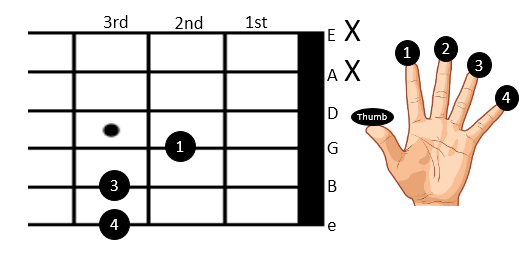
Place your 4th(little) finger on the third fret of the first string,
your 3rd(ring) finger on the third fret of the second string, and
your 1st(index) finger on the second fret of the third string.
Strum all the strings except the 5th string & 6th string.
Tips:
- Transitioning from D Major: Dsus4 is often used in place of or alongside the D major chord. When transitioning from D to Dsus4, you only need to add your pinky finger on the 3rd fret of the high E string. This makes it an easy and effective chord for building tension or creating dynamic changes in your playing.
- Finger Pressure: Press firmly enough to get a clean sound, but not so hard that it muffles the strings. Keep your fingers arched, especially your ring finger, to avoid muting the 1st string.
- Practice Switching: Practice moving from D to Dsus4 back and forth. It’s a simple change but crucial for smooth rhythm playing in many songs.
- Strumming: Only strum the top 4 strings. Strumming from the 4th string (D) downward ensures the correct tone and sound of the chord. Muting the low E and A strings with your thumb or palm may help.
- Use in Music: The Dsus4 chord is frequently used in pop, rock, and folk songs. It adds a sense of suspense or tension that resolves beautifully when played back to D major.
With practice, you’ll be able to incorporate Dsus4 smoothly into your playing, enriching the sound of songs and chord progressions!
